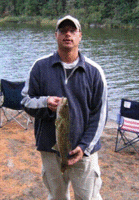Benthic macroinvertebrate stoichiometric implications for North Dakota and Minnesota fisheries

Daniel C. McEwen (PhD Student)
Department of Biological Sciences
Email: daniel.mcewen@ndsu.edu
BA, Biology (2003)Minnesota State University - Moorhead
Fellow: Daniel C. McEwen, Department of Biological Sciences, NDSU
Advisor: Malcolm G. Butler, Professor of Zoology, NDSU
Matching Support: NDSU
Degree Progress: Ph.D. expected in December 2008
Benthic macroinvertebrate stoichiometric implications for North Dakota and Minnesota fisheries
A primary motivation for managing many aquatic systems is fisheries production and community structure. Economic and recreation pressures prevail for creating and maintaining good fisheries. Millions of dollars have been appropriated by North Dakota for fisheries management. Successful implementation of management programs call for an understanding of the kinds of environmental characteristics that are amenable to the production of desired fish species. While many environmental factors contribute to the structuring of fish communities, the role of food quality in terms of benthic invertebrate stoichiometric constraints is not known but may be significant. The reason that little is known about these potential constraints is that high quality data on benthic invertebrate stoichiometry is not available. I propose to address questions relating benthic invertebrate food quality to fisheries community structuring by determining stoichiometric values for common North Dakota and Minnesota benthic invertebrates at a fine taxonomic resolution. I will explore how the structure of different macrobenthic communities may constrain fish communities or growth rates by relating our data to lake surveys of fishes.
Objectives and Methods:
I propose a research program addressing taxonomy, stoichiometry, and benthic-pelagic coupling in the context of benthic constraints on fisheries in North Dakota and Minnesota lakes along a trophic gradient from oligotrophic to eutrophic. Stoichiometric analysis of benthic invertebrates, identified at high taxonomic resolution, will be assessed for variability in C, N, and P content, which will then be related to the nutritional needs of various fish species. I will also address sediment and water composition in stoichiometric terms.
Nonquantitative sampling will be conducted on 4 lakes in North Dakota and 4 lakes in Minnesota, targeting species of Chironomidae, Ephemeridae, and Amphipoda. Macrobenthic invertebrate samples will be collected with an Ekman grab and preserved in 95% ethanol or dried for elemental analysis. Preserved benthos will be separated from lake sediments using a sucrose-floatation procedure. I will separate organisms into course scale taxonomic categories using a stereoscope and make head mounts or photographs of pertinent morphological characteristics of individual animals. Stoichiometric analyses will be made by the University of Nebraska via mass spectrophotometry and standard methods will be used for phosphorus analysis. Stoichiometric relationships will be derived for invertebrate taxa at varying developmental stages to evaluate variation within species. These data will be used in bioenergetic and resource competition models to predict likely fish community structure.
Project Progress:
Invertebrates were sampled during the summer of 2005 at 4 North Dakota lakes (Metigoshe, Warsing, Crooked, and Danzig) and 4 Minnesota lakes (Rainy, Namakan, Kabetogama, and Christina). Benthos have been sorted, dried, and weighed for stoichiometry analyses, and quantitative samples are being identified to determine community structure. I am currently conducting phosphorus analyses and preparing samples to send away for carbon and nitrogen analysis.
Significance of Research:
Several results have the potential for advancing our understanding and management of North Dakota’s water resources. Many hypotheses related to materials cycling through aquatic communities cannot be tested because of limited knowledge of macroinvertebrate body stoichiometry at fine-scale taxonomic resolution. These data will be collected and published. Should significant stoichiometric relationships between fish and their prey be established, our results could have significant management implications for determining how much effort is put into the management of lakes for particular fish communities For example, stocking or habitat creation in lakes where nutrient regimes are not supportive of particular fish communities could be avoided, and resources could be directed toward more suitable environments.

Melcolm Butler
Biological Sciences
Office: Research 2, Room 214B
Phone: 701-231-7398
Email: malcolm.butler@ndsu.edu


